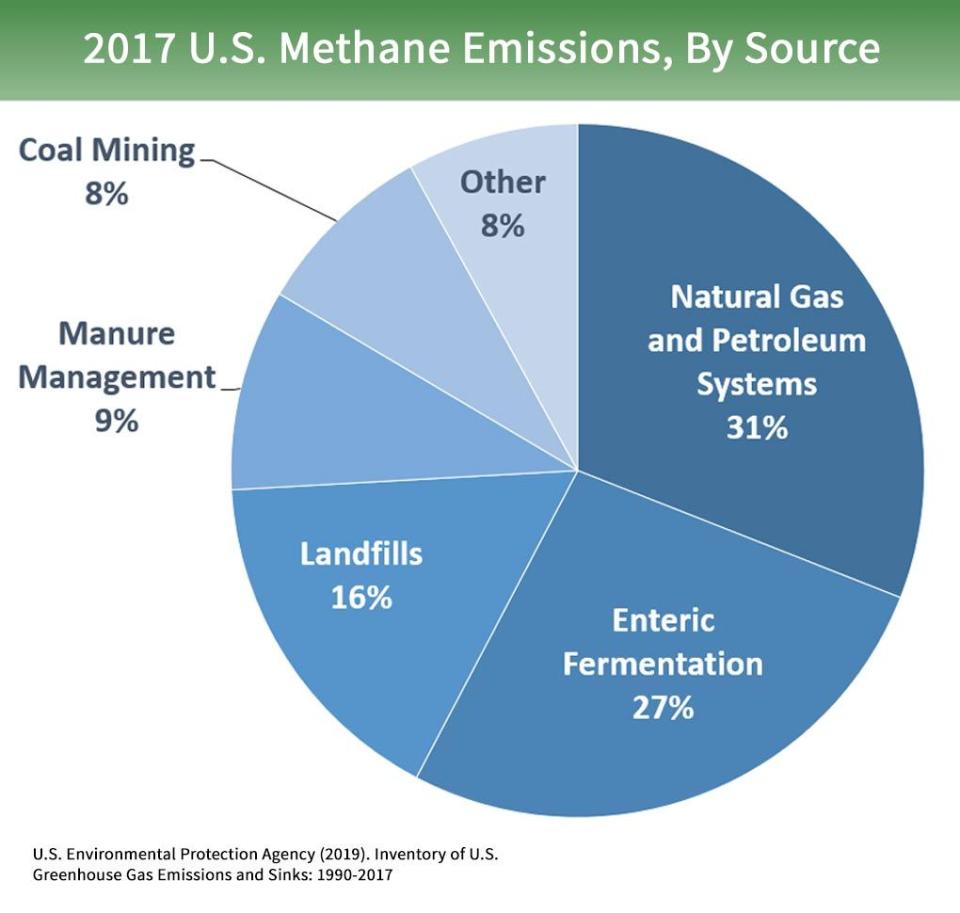The Ins and Outs of Methane: One of the Most Powerful Greenhouse Gases in the Atmosphere

“Hearst Magazines and Verizon Media may earn commission or revenue on some items through the links below.”
Methane is a colorless, odorless, and highly flammable gas, and the main component in natural gas, which is used to generate electricity and heat homes around the world.
Methane accounted for roughly 10 percent of all human-driven greenhouse gas emissions in the U.S. in 2017, according to the EPA.
The EPA announced in August 2019 that it would roll back regulations on methane gas.
Last year, the Environmental Protection Agency (EPA) announced it would begin to roll back Obama-era regulations on methane, a powerful greenhouse gas. Under the current rules, oil and gas operations are required to install controls that keep methane gas from leaking out of their equipment.
DIVE DEEPER ➡ Read best-in-class Earth science features and get unlimited access to Pop Mech , starting now.
The Trump administration argues the EPA doesn't have the authority to regulate methane gas under the Clean Air Act. But the move goes against the recommendation of some major players in the oil and natural gas industry, such as Shell, BP, and Exxon, which supported the 2016 regulations and have recently made public their commitment to curbing methane gas emissions.
So why is this such a big deal? Let's break it down.
What Is Methane, Anyway?
Methane (CH4) is a colorless, odorless, and highly flammable gas composed of one carbon atom and four hydrogen atoms. It can be produced naturally and synthetically, and when burned in the presence of oxygen, it produces carbon dioxide and water vapor.
Methane is the primary component of natural gas and is used to produce heat and electricity around the world. Methane is also used in chemical reactions to produce other important gases like hydrogen and carbon monoxide and carbon black, a chemical compound that's found in some types of rubber used in car tires.
The gas is also a significant contributor to climate change. In 2017, methane accounted for roughly 10 percent of all human-driven greenhouse gas emissions in the U.S., according to the EPA. While it isn’t the most abundant greenhouse gas in the atmosphere, it is among the most powerful.
Where Is Methane Found, and How Is It Released?
There are two main ways that methane can be naturally produced.
First, methane can be produced through a series of chemical reactions as organic matter is decomposed at shallow depths in low-oxygen environments, such as swamps and bogs. As plants die and sink to the bottom of these watery environments, bacteria starts to break them down. According to a study in the Proceedings of the National Academy of Sciences, wetlands are the single largest natural contributor to methane emissions. Additionally, methane can leak from mud volcanoes, rice fields, and strangely, termites.
Methane can also be found in underground fossil fuel deposits that have been subjected to high pressure and temperatures over millions and millions of years. As these fuels are harvested, mined, and released, so is methane. Methane is difficult to transport and easily leaks during the extraction of oil, coal, and natural gas—hence the regulations.
“If you’re trying to impact climate policy in the next 10 years, methane is a really good chemical to go after,” Daniel Varon, an atmospheric scientist at Harvard University, tells Popular Mechanics.
A form of methane mixed with ice, called methane gas hydrates, can be found trapped in layers of sediment on the ocean floor and beneath permafrost and frozen lakes in the Arctic. These solid, ice-like deposits have been touted as a potential energy source, but are particularly troubling because they can release large concentrated amounts of methane into the atmosphere.
According to the EPA, roughly 50 to 65 percent of U.S. methane emissions are related to human activity, while around 30 percent of human-related methane emissions are released by the natural gas and petroleum industry.
About 27 percent of methane emissions are generated through a process called enteric fermentation—cows burping and occasionally farting while they digest their food, basically—and 16 percent of global methane emissions are generated by organic waste decomposing in landfills. Methane can be also be released through the storage and use of manure for fuel (9 percent) and through coal mining (8 percent).

As for the belching bovines, a recent study published in Science Advances identified groups of microbes in cows' guts that cause enteric fermentation and suggested that selectively breeding cows to produce less gas might lower emissions.
So Why Is Methane Such a Big Deal?
Of all the greenhouse gases, methane is one of the most potent because of its ability to efficiently absorb heat in Earth’s atmosphere. Studies have shown that, over a 20-year period, a kilogram of methane warms the planet as much as 80 times more than a kilogram of carbon dioxide.
Methane lasts for maybe a decade in Earth's atmosphere before it begins to react with a free radical called hydroxyl and turns into carbon dioxide, where it can stay there for centuries.
Therefore, most of methane's time in the atmosphere as a molecule is spent as a CO2 molecule, Varon says. Far less methane is emitted into the air than carbon dioxide. "Just mitigating methane without mitigating CO2 is not going to be as helpful in the long term," he says. Still, methane leaves lasting impacts.
For example, one of these impacts is a phenomenon called thermal expansion. Greenhouse gases like methane heat up the atmosphere, and as much as 90 percent of that excess heat is absorbed by the oceans. This heat causes seawater to expand in volume. This effect, along with glacial melting, causes sea levels to rise.
Scientists have known for a long time that carbon dioxide heats Earth’s atmosphere and oceans, causing them to expand, but they only recently discovered that short-lived greenhouse gases like methane and CFCs (gases that contain chlorine or fluorine) also spur thermal expansion. In 2017, scientists ran computer simulations that showed thermal expansion caused by methane continues for centuries even after the gas has dissipated from the atmosphere.
And finally, there are health benefits to regulating methane. Emitting the gas can actually lead to higher levels of ozone in the atmosphere, says Varon. Ozone can cause a number of health problems such as shortness of breath and aggravate lung conditions like asthma, emphysema, and chronic bronchitis, according to the EPA.
“People have been measuring methane in the atmosphere with aircraft and ground instruments for a long time,” Varon says. He and his colleagues work with government agencies that use satellites to pinpoint where emissions are highest. This information can help identify facilities that are leaking methane and lead to better monitoring, and subsequently, regulations of oil and natural gas operations around the world.
Understanding where methane comes from can help us mitigate the impacts of climate change, but it’s still an uphill battle. The EPA’s latest rollback could make that hill a lot steeper.
An original version of this article stated that due to a chemical reaction most of methane's atmospheric lifetime is spent as a CO2 molecule. We've since clarified the statement to reflect that the chemical reaction occurs at the end of methane's atmospheric lifetime. We regret the error.
You Might Also Like


